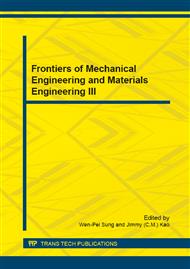[1]
C. F. Eubanks, S. Kmenta, and K. Ishii, System Behavior Modeling as a Basis for Advanced Failure Modes and Effects Analysis, presented at ASME Design Engineering Technical Conferences and Computers in Engineering Conference, Irvine, California (1996).
DOI: 10.1115/96-detc/cie-1340
Google Scholar
[2]
C. F. Eubanks, S. Kmenta, and K. Ishii, Advanced Failure Modes and Effects Analysis using Behavior Modeling, presented at ASME Design Engineering Technical Conferences and Design Theory and Methodology Conference, Sacramento, California (1997).
DOI: 10.1115/detc97/dtm-3872
Google Scholar
[3]
J. E. Hunt, D. R. Pugh, and C. P. Price, Failure Mode Effects Analysis: A Practical Application of Functional Modeling, Applied Artificial Intelligence, 9(1995) 33-44.
DOI: 10.1080/08839519508945466
Google Scholar
[4]
N. Hughes, E. Chou, C. Price, and M. Lee, Automating Mechanical FMEA Using Functional Models, presented at Proceedings of 12th International FLAIRS Conference (1999).
Google Scholar
[5]
R. M. Atkinson, M. R. Montakhan, K. D. A. Pillay, and D. J. Wollons, Automated Fault Analysis for Hydraulic Systems: Part 1- Fundamentals, Proc. Instn Mech. Engrs, Part I: J. Systems and Control Engineering, 206(1992) 207-214.
DOI: 10.1243/pime_proc_1992_206_336_02
Google Scholar
[6]
P. A. Hogan, C. R. Burrows, K. A. Edge, R. M. Atkinson, M. R. Montakhab, and D. J. Woollons, Automated Fault Analysis for Hydraulic Systems. Part 2- Application., Proc. Instn Mech. Engrs, Part I: J. Systems and Control Engineering, 206(1992).
DOI: 10.1243/pime_proc_1992_206_337_02
Google Scholar
[7]
A. Bouti, D. A. Kadi, and K. Dhouib, Automated Manufacturing Systems Failure Analysis based on a Functional Reasoning, presented at Proceedings of the 10th ISPE-IFAC International Conference on CAD/CAM (1994).
Google Scholar
[8]
C. J. Price, D. R. Pugh, M. S. Wilson, and N. Snooke, The Flame System: Automating Electrical Failure Modes & Effects Analysis (FMEA), presented at Proceedings of the Annual Reliability and Maintainability Symposium (1995).
DOI: 10.1109/rams.1995.513228
Google Scholar
[9]
P. C. Teoh and K. Case, Modelling and Reasoning for Failure Modes and Effects Analysis Generation, Proc. Instn Mech. Engrs, Part B: J. Engineering Manufacture, 218(2004) 289-300.
DOI: 10.1243/095440504322984849
Google Scholar
[10]
R. B. Stone and K. Wood, Development of a Functional Basis for Design, Journal of Mechanical Design, 122(2000) 359-370.
Google Scholar
[11]
I. Y. Tumer and R. B. Stone, Mapping Function to Failure Mode during Component Development, Research in Engineering Design, 14(2003) 25-33.
DOI: 10.1007/s00163-002-0024-y
Google Scholar


